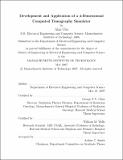Development and application of a 4-dimensional Computed Tomography simulator
Author(s)
Chu, Alan
DownloadFull printable version (8.522Mb)
Alternative title
4D CT simulator
Other Contributors
Massachusetts Institute of Technology. Dept. of Electrical Engineering and Computer Science.
Advisor
George T.Y. Chen, William M. Wells, Gregory C. Sharp and John A. Wolfgang.
Terms of use
Metadata
Show full item recordAbstract
This thesis presents the development and application of a 4-Dimensional Computed Tomography (4D CT) simulation program. The simulation is used to understand and quantify the sources of image artifacts that arise from irregular patient breathing during 4D CT. Performance of the simulation is validated by comparing the simulation results with those of phantom experiments with CT scanners. The program simulates 4D CT scanning of objects of arbitrary size and shape and is extended to investigate the accuracy of gated radiotherapy. Experiments are performed using realistic breathing patterns from patients, in addition to synthetic ones for various studies. The simulation is used to study the effects of scan start time shift, breathing trace baseline drift, and hysteresis of internal organ and abdominal surface motion on the quality of 4D CT images. While 4D CT significantly reduces artifacts from helical scans of the thoracic and abdominal areas, a variety of different sources can still contribute to motioninduced artifacts in 4D CT. Since 4D CT is used to determine target margins for radiotherapy, proper precaution should be taken so that image artifacts do not lead to inaccurate treatment planning. Finally, this thesis discusses improvements in 4D CT and suggests additional methods to improve treatment planning for radiotherapy.
Description
Thesis (M. Eng.)--Massachusetts Institute of Technology, Dept. of Electrical Engineering and Computer Science, 2007. This electronic version was submitted by the student author. The certified thesis is available in the Institute Archives and Special Collections. Includes bibliographical references (p. 93-95).
Date issued
2007Department
Massachusetts Institute of Technology. Department of Electrical Engineering and Computer SciencePublisher
Massachusetts Institute of Technology
Keywords
Electrical Engineering and Computer Science.